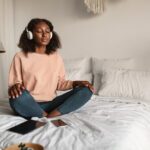All people experience anxiety. It’s completely normal to feel anxious sometimes in response to events and circumstances in life, like a big job interview, an exam, or a first date. But sometimes, the symptoms of anxiety persist even after that event or circumstance has long since passed. If you experience ongoing anxiety that interferes with your life, it could be a sign of a clinical disorder.
All people experience anxiety. It’s completely normal to feel anxious sometimes in response to events and circumstances in life, like a big job interview, an exam, or a first date. But sometimes, the symptoms of anxiety persist even after that event or circumstance has long since passed. If you experience ongoing anxiety that interferes with your life, it could be a sign of a clinical disorder.
What are the symptoms of anxiety?
Anxiety is much more than feeling worried or nervous. Often it’s a full-body experience that impacts how you think, how you feel physically and emotionally, and how you act in the world.
What triggers anxiety can also vary widely from person to person, and many causes contribute to the development of anxiety disorders. These include genetics, upbringing, environment, personality, mental habits, and life experiences.
When it comes to clinical anxiety, there are multiple types of disorders, including panic disorder, social anxiety disorder, phobias, and generalized anxiety disorder.
Even across subtypes, anxiety disorders share common symptoms. These symptoms that follow are drawn from the GAD-7 and Beck Anxiety Inventory (BAI), two standard tools used by practitioners and researchers to track symptoms and severity without differentiating sub-type.
Cognitive:
- Fearing the worst will happen (catastrophizing)
- Worry that feels excessive or uncontrollable
- Fear of losing control
Physical:
- Feeling so restless it’s hard to sit still
- Trembling hands or wobbly legs
- Heart racing
- Feeling hot or light-headed
- Tension or difficulty relaxing
- Issues with sleep, such as insomnia
- Nausea and stomach upset
- Headaches
- Sweating
Emotional:
- Fear
- Irritability and anger
- Nervousness
- Agitation
- Restlessness
Behavioral:
- Avoidance
- Withdrawal and isolation
- Procrastination
- Body focused repetitive behaviors (BFRBs) like hair-pulling, nail-biting, and skin-picking
Understandably, these symptoms can make it very difficult to move through the world. That’s because they impact your energy levels, interactions with other people, daily routines, and effectiveness at work, school, or home.
The main difference between symptoms of severe anxiety and the symptoms of anxiety disorders, in general, is the extent to which they impact your life.
One way to gauge severity is to ask yourself this question: “How difficult have these issues made it for me to do my work, take care of things at home, or get along with other people?”
Factors of anxiety
The 3 C’s are helpful factors to keep in mind when looking at the signs and symptoms of anxiety.
1. Commonality:
Anxiety disorders have the highest prevalence of any mental health disorder in the US, impacting nearly 20% of adults each year. Many more experience symptoms of anxiety without fitting the diagnostic criteria of an anxiety disorder. Since COVID-19, this number is only rising.
2. Continuum:
Anxiety occurs on a continuum. It can occur in manageable doses that are tolerable and shift naturally. Think of this as “everyday anxiety.” It can also be experienced at levels that make it difficult to function.
3. Contrast:
Although there are shared experiences and symptoms of anxiety, there is significant variation across individual experience.
Here’s why these can be such helpful reminders. Recognizing commonality reminds us that we’re not alone and that anxiety is something that deserves our attention.
Knowing there’s a broad continuum helps us avoid minimization and misunderstandings. For example, if someone suggests an overly simplistic, quick-fix solution, they probably don’t understand the debilitating nature of anxiety disorders.
Appreciating the contrast and variance across individual experiences, and even our own experience at different points in time, helps us accept that not all information about anxiety, nor all types of treatment, will apply across the board.
What anxiety can look like to outsiders
Anxiety signs are different from symptoms in that they are observable. Often, the signs of anxiety others observe are muted compared to the symptoms of anxiety you experience internally.
For example, someone who appears to be calmly gliding through life may be using all their energy just to stay afloat.
The stark contrast between how we feel on the inside and how we present on the outside is so common at certain universities that it’s gained its own (non-clinical) term, “duck syndrome.”
The internal-external disconnect can be isolating and feel like a relief at the same time. On the one hand, there’s often a desire to hide our pain and difficulties, to seem more okay than we are.
On the other hand, we have an inherent desire to be seen, understood, and accepted. Finding at least one trusted person to share your experience with, whether they’re a professional or a friend, can ease some of the added pain of feeling like you’re going through it all alone.
Do weighted blankets really work for anxiety? Learn more here.
What you can do to ease anxiety
The good news is that anxiety disorders and anxiety symptoms are highly treatable. Research indicates that anxiety disorders are best treated through a combination of medical evaluation, talk therapy, and lifestyle strategies.
Unfortunately, only 36.9% of those with anxiety receive treatment. In my experience as a therapist, part of the treatment gap is due to the myth of controllability, or the false belief that with effort, we should be able to just stop the symptoms of mental health challenges through effort alone.
But merely wishing anxiety away doesn’t work. And without any intervention, mild anxiety can grow into severe anxiety symptoms. Plus, ongoing or chronic anxiety often has harmful effects on the body.
Effective anxiety treatment usually includes a combination of the following tools and strategies.
Medication
You can meet with a healthcare professional at Lemonaid for a medical evaluation. Your practitioner can diagnose an anxiety disorder and make suggestions about prescription medications to help.
Therapy
Talking to a licensed therapist or counselor can help you better understand your anxiety and address the underlying causes and contributors. Your therapist may also teach you strategies that help you manage difficult symptoms.
Behavioral and lifestyle changes
Effective self-care strategies include guided relaxation training, regular exercise, healthy sleep habits, self-help books based on cognitive behavioral therapy (CBT), and mindfulness.
Learn some simple ways to practice mindful breathing now.
Takeaway
- Anxiety and anxiety disorders can manifest with a range of signs and symptoms.
- Anxiety is common, exists on a spectrum, and varies from person to person.
- Some of the most common symptoms are excessive worry, catastrophizing, restlessness, tension, elevated heart rate, agitation, and irritability.












